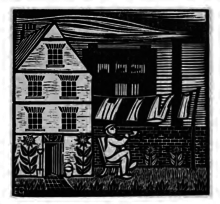Eric Gill
| |
|---|---|

Self-portrait
| |
| Born |
Arthur Eric Rowton Gill
22 February 1882
Brighton, Sussex, England, United Kingdom
|
| Died | 17 November 1940 (aged 58)
Middlesex, England, United Kingdom
|
| Education |
|
| Known for | Sculpture, typography |
| Movement | Arts and Crafts movement |
Arthur Eric Rowton Gill ARA (/ɡɪl/;[1] 22 February 1882 – 17 November 1940) was an English sculptor, typeface designer, and printmaker, who was associated with the Arts and Crafts movement. He is a controversial figure, with his well-known religious views and subject matter generally viewed as being at odds with his sexual behaviour, including his erotic art and sexual abuse of his daughters, sisters, and dog.
Gill was named Royal Designer for Industry, the highest British award for designers, by the Royal Society of Arts. He also became a founder-member of the newly established Faculty of Royal Designers for Industry.
Contents
Published words[edit]
Gill published numerous essays on the relationship between art and religion, and a number of erotic engravings.[30]
Some of Gill's published writings include:
- A Holy Tradition of Working: An Anthology of Writings[31]
- Clothes: An Essay Upon the Nature and Significance of the Natural and Artificial Integuments Worn by Men and Women[32]
- An Essay on Typography[33]
- Christianity and Art, 1927
- Art, 1934
- Work and Property, 1937[34]
- Work and Culture, 1938
- Twenty-five nudes, 1938[35]
- Autobiography: Quod Ore Sumpsimus[36]
- Notes on Postage Stamps[37]
- Christianity and the Machine Age, 1940.[38]
Gill also provided woodcuts and illustrations for a range of other books.
Jonathan Cape, 1940 (published posthumously) Autobiography: Quod Ore Sumpsimus. ISBN 1-870495-13-6
Quod Ore Sumpsimus
https://forums.catholic.com/t/purification-of-the-sacred-vessels-the-quod-ore-sumpsimus/92277/2


沒有留言:
張貼留言